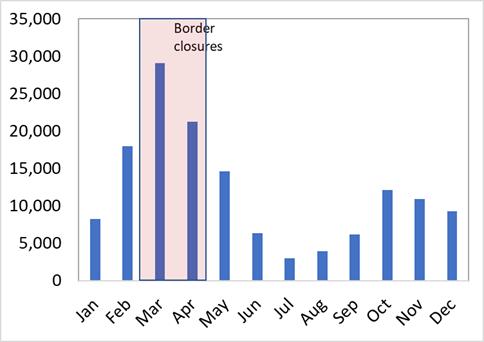
7 minute read
3. Challenges international labor migrants face resulting from the COVID outbreak
a barrier. Finally traveling back to their countries has been challenging especially for students. In principle, people legally residing in Armenia are entitled to social protection benefits and services, including the emergency benefits under the social packages. In practice, however, most of them do not have access to social benefits and services due to lack of required documentation, limited flexibility in an administration system (e.g., not recognizing foreign birth certificates) and language barriers. Statistics on the social protection coverage by migration status are neither monitored nor available.
Temporary labor migration is the more prevalent type of migration in Armenia: more than 52% of international migrants and more than 64% of returnees leave Armenia for seasonal jobs (RAU 2018). Search for better jobs opportunities is the main push factor for international migrants, especially among low educated Armenians, while better educated migrants often emigrate for other reasons, further study, family reunion.
Advertisement
The Russian Federation is the main country of destination for Armenian migrant workers. About 95 percent of temporary migrants go to the Russian Federation, mostly for temporary jobs. Those who are going to EU, USA or Canada, tend to be for permanent residence and to study8 . Several reasons explain why this Russia corridor has been the main one in the past decades, including the visa free regime, the solid migrant networks, low transportation costs and Armenians’ knowledge of the Russian language, all of which contribute to reduce the overall migration cost.
Border crossings declined sharply during the first three month of 2020. The number of exits through the Armenian border crossing points in the period between January and March 2020 decreased by 21 percent among Armenian nationals and by 13 percent in total with respect to the previous year (Table 1). Similarly, inflows decreased by 17 percent overall, more than half of these inflows were Armenian repatriating.
Table 1. Number of entries and exits through Armenian borders (January-March, 2020)
Border Crossing Points
2020
2019
2018 Inflow Outflow
Total
615,020 Including with RA documents Total
346,625 626,772 Including with RA documents 328,016
719,531 420,065 722,994 417,539
683,759 387,477 684,336 390,172
Source: ARMSTAT.
Armenian labor migrants’ inability to travel may explain the decline. Temporary migrants’ movements (departure and return) in general peak in March, followed by April of a year (Figure 1.a.). It is estimated that about 50 percent of temporary international migrants leave between March and June for their seasonal jobs (ILCS 2018). A third of them return home after 3-7 months of stay (Figure 1.b). The departure timeline corresponds with the period when most travel restrictions have taken effect. It is then quite plausible that many of these migrants were unable to leave for destinations as the Armenian authorities imposed travel restrictions in mid-March and Russia banned the entire air travel on March 18 (and still in effect at the time of writing). Furthermore, border closures in both countries might have created a
8 Still close to 80 percent of permanent migrants go to Russia.
situation where Armenian migrants who completed their employment or were laid-off owing to shrinking demand are unable to return to Armenia, as seen in other countries. To ensure these migrants’ livelihood, Qatar and the United Arab Emirates, for instance, provided them with free food and shelter until they were able to depart for home countries.
Figure 1. International labor migrant mobility
(a) Number of departures and returns (b) Share of migrants by duration in destinations
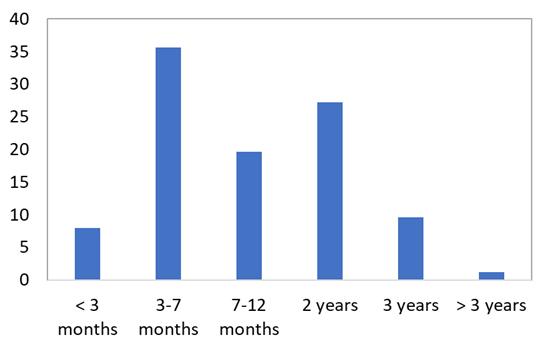
Source: ILCS 2018. Source: RAU 2018.
No-departure of migrants could bear implications for the domestic job market, as international migrants tend to be of prime working age than stayers (Figure 2.a). Those in the 25-54 age group account for 77 percent in the migrant population, as opposed to 53 percent in the survey data of the Russian-Armenia University – taking up 75 percent. People would go abroad for work after completing their education and repeat seasonal labor migration for some time: a quarter of migrants had three or more seasonal migration episodes, according to a returnee survey (ETF, 2012).
Migrants are more likely to be low or semi-skilled – potentially with heightened job risks in both Armenia and in destination countries. Majority of them hold secondary education (Figure 2.b). This contrasts to population mobility within Armenia: more than half of internal migrants are with tertiary education (Honorati et al, 2019a). This might owe to the fact that students go to bigger cities to attend universities and remain in such places after completing their education, while international labor migrants move after completing their schooling. Low/ semi-skilled jobs have a less degree of work-from-home features, and are less mobile, than high-skilled ones and therefore tend to be more exposed to loss risks during the pandemic.
Most migrants are married, and their income loss could increase vulnerability of migrant households. Married migrants predominantly travel alone, leaving their spouses behind to take care of the children or other dependents (ETF, 2012). This may owe to the fact that migration is seasonal – for instance to buffer a drop-in income during lean agriculture seasons, or to respond to seasonal demand in construction and agriculture sectors in destination countries. Temporary labor migration without accompanying spouses and family members also owe to migration regimes of destination countries – i.e., not permitting family members to accompany temporary labor migrants.
Disruptions in seasonal migration – either no departure or no return - may increase gender disparities in Armenia, mostly among migrant households. Temporary labor migration in Armenia is male-dominated –nearly all migrants being males (Figure 2.c). Feminization in labor migration, as seen in South East Asian countries, is yet to take place in Armenia. While males work abroad, women take up tasks previously performed by their male partners, in addition to their existing responsibilities (Menjivar and Agadjanian, 2007). Some evidence suggests that women in migrant households are less likely to engage in wage employment but more likely to be self-employed, perhaps owing to an ease of credit constraints from remittances (e.g., in Egypt, Binzel and Assaad, 2009). In Armenia, women in general and mothers of children less than 12 years old whose husbands have been temporarily abroad for work have similar labor force participation rates than women whose husband are present in the household (Honorati et al. 2019b). In China, return migration does not appear to reverse these labor allocation changes (Démurger,2015); in Georgia, on the other hand, females transfer the male tasks that they assumed during male migration, once males return (Torosyan et al., 2018). In case when male migrants have not been able to return after losing or ending their employment in destination countries – i.e., no further remittances, it could force women and other family members to substitute for the loss income from the migrants. It is unlikely that potential male migrants, who were unable to leave, would increase their burden sharing in household responsibilities, given that Armenia sees ‘the persistence of gender norms emphasizing women’s roles as mothers and household caretakers’ (World Bank, 2017b, p. 2).
Figure 2. Migrant profiles
A. Age - migrants (leavers) vs. stayers (percent of the respective population)
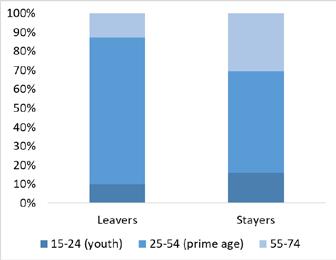
B. Education (percent of the respective population)
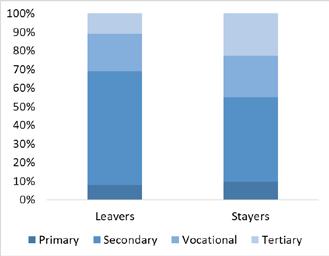
C. Marital status and gender in the migrant population (percent)
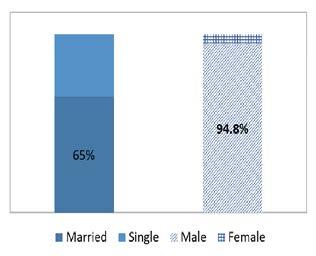
Source. ILCS 2018.
When back home earlier than planned, furthermore, returnees face several challenges including limited employment opportunities, foregone foreign income, debts accumulated to finance migration costs that would have been paid with higher incomes earned at the destination.
Despite these challenges, the emergency social packages approved in response to the crisis are not designed to target income support to families with migrants. Migrant families with children less than 18 years old could receive income support through child subsidies designed for all families with children less than 18 years old. Migrants households are less likely to be eligible to the Family Benefit Program9 “traditional” social protection support: Only 23 percent of beneficiary households have a household member temporarily abroad (ILCS 2018). By design of the program, they are less likely to be eligible, as
9 The Family Benefit program is the main social safety net program in the country targeted to extreme poor and socially vulnerable households.




